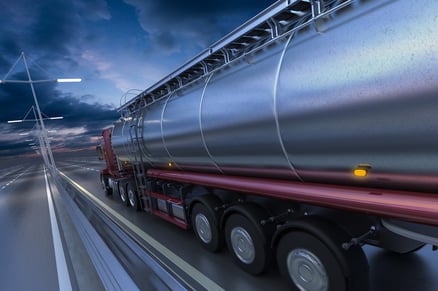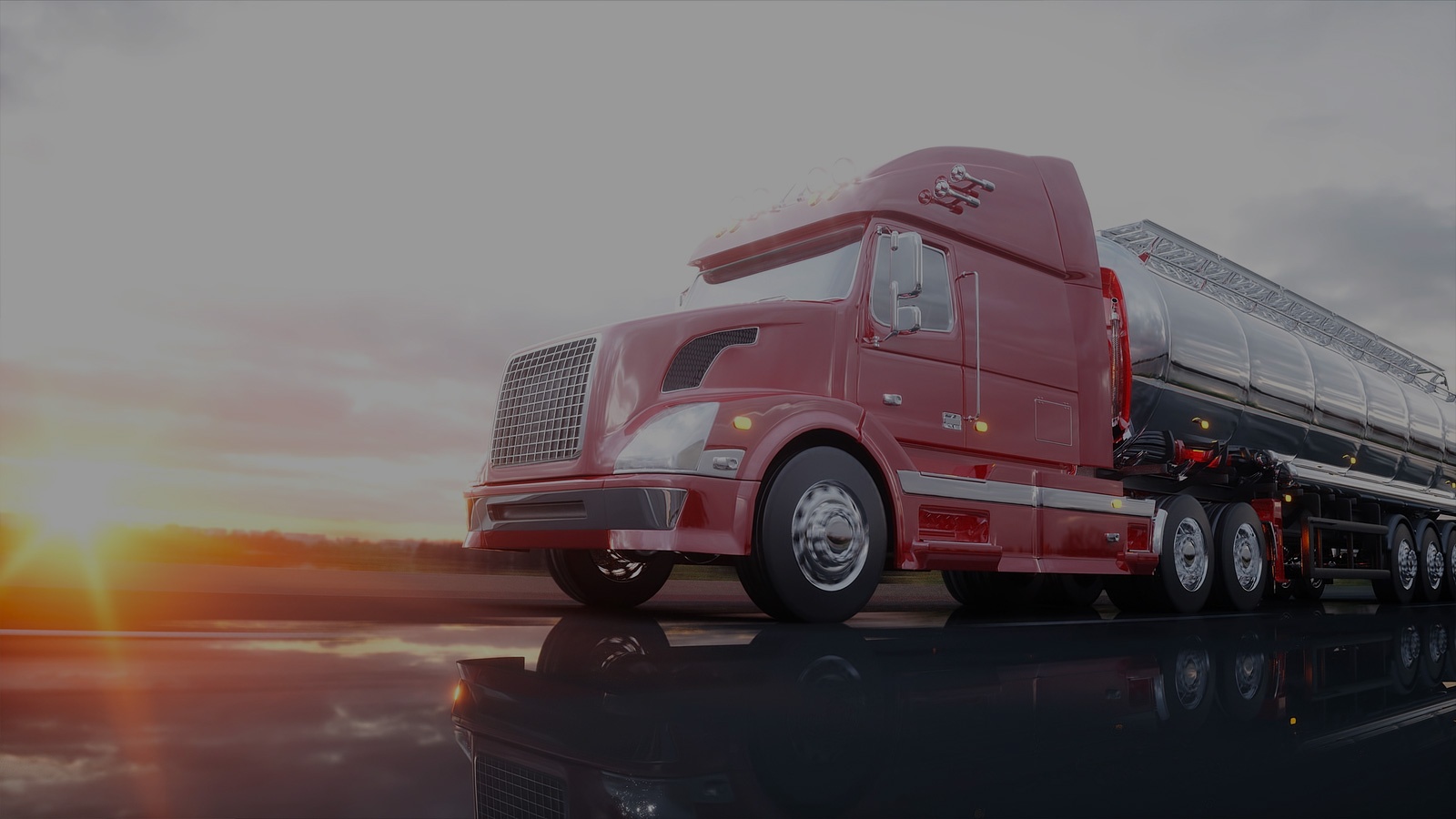When choosing a bulk freight carrier, the tanks and equipment used in bulk liquid transportation are critically important – far more so than selecting a carrier for dry van freight, where most any trailer will do. With bulk liquid transportation, the tank can spell the difference between a successful load and an expensive mess. In this article, we’ll examine bulk liquid tanks in greater detail and tell you what you need to know about them before booking your next load.
Bulk liquid tank characteristics
Material
 Bulk liquid tanks are made of stainless steel or aluminum, with stainless steel being most common. 307-alloy stainless steel – known for its versatility – was once an industry standard and is still used to ship certain classes of chemicals. In recent years, however, alloys such as 316 and 317 have become more popular due to their higher levels of nickel and their enhanced ability to handle certain corrosive materials.
Bulk liquid tanks are made of stainless steel or aluminum, with stainless steel being most common. 307-alloy stainless steel – known for its versatility – was once an industry standard and is still used to ship certain classes of chemicals. In recent years, however, alloys such as 316 and 317 have become more popular due to their higher levels of nickel and their enhanced ability to handle certain corrosive materials.
Insulation
Bulk liquid tanks are either insulated or non-insulated. Non-insulated tanks are also referred to as “skin tanks.” Insulated tanks have a layer of fiberglass that surrounds the tank and a sheath of stainless steel over that. Insulated tanks are most common due to their Thermos®-like ability to keep warm products warm and cold products cool during transit. Insulated tanks can also carry products that non-insulated tanks can carry, but the reverse is not true. And, as they are the most common type of tank, insulated tanks also increase the odds of securing a backhaul after product delivery, which can reduce the cost of the load.
In-transit heating
Bulk liquid tankers with in-transit heating capabilities have a series of steam coil lines at the bottom of the tank. This in-transit system does not actually heat the liquid in the tank. Rather, it assists in maintaining the product’s existing heat. Power from the truck heats and circulates coolant from the radiator through the steam coil lines in a continuous cycle. When running at full strength – typically after 4 hours of continuous driving – this system reaches a maximum temperature of 160˚F.
Volume
The typical liquid bulk trailer holds 6,000-7,000 gallons. Some carriers offer “tight fill” tanks that hold only up to 5,000 gallons. By filling these smaller tanks completely, you ensure that the liquid won’t get agitated in transit, reducing the chance of forming foam. Foam is nearly impossible to unload from a trailer, leaving you with a “heel” of unusable product, which you’ll be forced to discard.
Compartments
Most bulk liquid tanks are single compartment tanks – the entire tank is one big compartment. Other tanks are segregated into two, three, four, or even five compartments. With multi-compartment tanks, each compartment can house a different chemical and has its own unloading valve.
Loading and unloading
At the top of the tank is a dome, which is opened for loading the trailer. Air compressors or pumps are used to load and unload bulk liquids. An air compressor – which blows compressed air through a hose – is typically the preferred method as it’s more convenient and makes less of a mess.
For unloading, the tank will have either a rear or center unload mechanism. With rear unload, there is a discharge valve in the back of the trailer. This is preferable when the driver is backing down a ramp to unload. With center unload, the trailer floor will slope down to the middle from the front and rear, and there is a valve in the center. Some center-unload tanks will have a pipe running along the middle of the tank so that it can also be unloaded in the rear.
Specialized tanks
In addition to the characteristics described above, there are specialized tanks designed to haul specific types of products. Food-grade trailers, for instance, are insulated stainless steel tanks that have a sanity valve (a special covering that protects the valve from dirt and elements). Kosher tanks have been blessed in accordance with religious customs. And tanks for acids or other types of chemicals may be rubber-lined, polyethylene or plastic.
Working with a bulk freight 3PL
There are many choices, and it’s important to choose correctly. It can be overwhelming. How do you know what’s best for your product, as well as your loading and unloading facilities?
Fortunately, there are experts that can help, including bulk freight 3PLs that know your products and know how to find the bulk liquid tanks, drivers, and equipment to haul it best.
These bulk freight 3PLs, or bulk freight brokers, do not have trucks and tanks of their own. What they do have, however, is a large network of carriers that they partner with. After learning more about your product, the 3PL can then play the role of matchmaker to find the carrier best equipped to handle it.
The following are other advantages of working with a bulk freight 3PL.
Cut freight costs. A bulk freight 3PL can leverage the size of its network to find the best carrier for a shipper’s load based on experience, equipment and cost. A 3PL can essentially ‘comparison shop’ on behalf of their shipping customers.
Move freight fast. Again, the large size of a 3PL’s carrier network allows for greater flexibility in meeting the timelines of shippers. From there, communication is vital to iron out schedules that work for shippers and destination facilities. The 3PL can also factor in stops to tank washes and other items.
Remove demands of traffic management. When a shipper books a load with a carrier, that shipper typically must allocate internal resources to track that load and manage the timeline and stakeholder expectations. 3PLs can handle those tasks on the shipper’s behalf.
Provide multiple transportation modes. Some 3PLs, like Bulk Connection, that specialize in bulk freight shipping can handle transportation across liquid and dry bulk freight, effectively giving shippers a ‘one-stop-shop’ for their transportation needs.
Maintain carrier information. For shippers going it alone and working with different carriers directly, there can be a lot of work that goes into maintaining the carriers’ licensing, insurance and regulatory compliance information. Some 3PLs have a dedicated team whose responsibility it is to keep these records updated and ensure that the 3PL’s TMS system assigns shippers’ loads ONLY to carriers that are up-to-date and qualified to handle them.
Perform coordination among stakeholders. When a bulk freight 3PL is a true expert, it understands that there are many details that make the difference between a successful and unsuccessful load. As such, these 3PLs will oversee the entire process. This includes calling both the loading and unloading facilities to confirm key items like operating hours, on-site staffing, and the necessary equipment. It also means staying in contact with stakeholders until the load is completed.
Lean on Bulk Connection to get liquid products in motion
The success of your business and even the health of the public can depend on your liquid bulk freight being transported safely and efficiently. Don’t leave it to chance – leave it to an expert. Bulk Connection is an ISO-9001-certified freight specialist that has been handling bulk liquid loads since 1987. We have a team of bulk freight specialists – many with over 20 years of industry experience – at the ready to help you protect the safety and integrity of your products in transit. To learn more about working with a true bulk liquid freight expert, contact Bulk Connection today.





